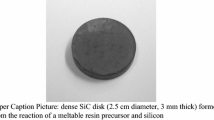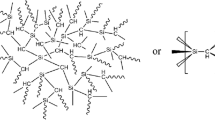Abstract
SiBN ceramics are widely considered to be the most promising material for microwave-transparent applications in harsh environments owing to its excellent thermal stability and low dielectric constant. This work focuses on the synthesis and ceramization of single-source precursors for the preparation of SiBN ceramics as well as the investigation of the corresponding microstructural evolution at high temperatures including molecular dynamic simulations. Carbon- and chlorine-free perhydropolysilazanes were reacted with borane dimethyl sulfide complex at different molar ratios to synthesize single-source precursors, which were subsequently pyrolyzed and annealed under N2 atmosphere (without ammonolysis) to prepare SiBN ceramics at 1100, 1200, and 1300 °C with high ceramic yield in contrast to previously widely-used ammonolysis synthesis process. The obtained amorphous SiBN ceramics were shown to have remarkably improved thermal stability and oxidation resistance compared to amorphous silicon nitride. Particularly, the experimental results have been combined with molecular dynamics simulation to further study the amorphous structure of SiBN and the atomic-scale diffusion behavior of Si, B, and N at 1300 °C. Incorporation of boron into the Si—N network is found to suppress the crystallization of the formed amorphous silicon nitride and hence improves its thermal stability in N2 atmosphere.

Article PDF
Similar content being viewed by others
Avoid common mistakes on your manuscript.
References
Riedel R, Kienzle A, Dressler W, et al. A silicoboron carbonitride ceramic stable to 2,000 °C. Nature 1996, 382: 796–798.
Riley FL. Silicon nitride and related materials. J Am Ceram Soc 2000, 83: 245–265.
Bocanegra-Bernal MH, Matovic B. Mechanical properties of silicon nitride-based ceramics and its use in structural applications at high temperatures. Mater Sci Eng A 2010, 527: 1314–1338.
Ionescu E, Kleebe H-J, Riedel R. Silicon-containing polymer-derived ceramic nanocomposites (PDC-NCs): Preparative approaches and properties. Chem Soc Rev 2012, 41: 5032–5052.
Eichler J, Lesniak C. Boron nitride (BN) and BN composites for high-temperature applications. J Eur Ceram Soc 2008, 28: 1105–1109.
Zhou Y, Hyuga H, Kusano D, et al. Development of high-thermal-conductivity silicon nitride ceramics. J Asian Ceram Soc 2015, 3: 221–229.
Colombo P, Mera G, Riedel R, et al. Polymer-derived ceramics: 40 years of research and innovation in advanced ceramics. J Am Ceram Soc 2010, 93: 1805–1837.
Mukhopadhyay A, Basu B. Consolidation-microstructure-property relationships in bulk nanoceramics and ceramic nanocomposites: A review. Int Mater Rev 2007, 52: 257–288.
Sommers A, Wang Q, Han X, et al. Ceramics and ceramic matrix composites for heat exchangers in advanced thermal systems—A review. Appl Therm Eng 2010, 30: 1277–1291.
Wang H, Singh RN. Thermal shock behaviour of ceramics and ceramic composites. Int Mater Rev 1994, 39: 228–244.
Riedel R, Ruswisch LM, An LN, et al. Amorphous silicoboron carbonitride ceramic with very high viscosity at temperatures above 1500 °C. J Am Ceram Soc 1998, 81: 3341–3344.
Wang ZC, Aldinger F, Riedel R. Novel silicon-boron-carbon-nitrogen materials thermally stable up to 2200 °C. J Am Ceram Soc 2001, 84: 2179–2183.
Wan JL, Duan RG, Gasch MJ, et al. Highly creep-resistant silicon nitride/silicon carbide nano-nano composites. J Am Ceram Soc 2006, 89: 274–280.
Ge KK, Ye L, Han WJ, et al. Pyrolysis of polyborosilazane and its conversion into SiBN ceramic. Adv Appl Ceram 2014, 113: 367–371.
Zhou C, Gao X, Xu Y, et al. Synthesis and high-temperature evolution of single-phase amorphous Si-Hf-N ceramics. J Eur Ceram Soc 2015, 35: 2007–2015.
Liao NB, Xue W, Zhang M. Molecular dynamics investigation of Si-B-N ceramics: Effects of boron content. Model Simul Mat Sci Eng 2012, 20: 035009.
Yu ZJ, Yang YJ, Mao KW, et al. Single-source-precursor synthesis and phase evolution of SiC-TaC-C ceramic nanocomposites containing core-shell structured TaC@C nanoparticles. J Adv Ceram 2020, 9: 320–328.
Wen QB, Xu YP, Xu BB, et al. Single-source-precursor synthesis of dense SiC/HfCxN1−x-based ultrahigh-temperature ceramic nanocomposites. Nanoscale 2014, 6: 13678–13689.
Ionescu E, Bernard S, Lucas R, et al. Polymer-derived ultra-high temperature ceramics (UHTCs) and related materials. Adv Eng Mater 2019, 21: 1900269.
Liu XM, Yu ZJ, Ishikawa R, et al. Single-source-precursor derived RGO/CNTs-SiCN ceramic nanocomposite with ultra-high electromagnetic shielding effectiveness. Acta Mater 2017, 130: 83–93.
Wen QB, Yu ZJ, Riedel R. The fate and role of in situ formed carbon in polymer-derived ceramics. Prog Mater Sci 2020, 109: 100623.
Yu ZJ, Lv X, Lai SY, et al. ZrC-ZrB2-SiC ceramic nanocomposites derived from a novel single-source precursor with high ceramic yield. J Adv Ceram 2019, 8: 112–120.
Yu ZJ, Lv X, Mao KW, et al. Role of in situ formed free carbon on electromagnetic absorption properties of polymer-derived SiC ceramics. J Adv Ceram 2020, 9: 617–628.
Jin SY, Guo KK, Qi HM, et al. High yield polyborosilazane precursor for SiBN ceramics. Adv Mater Res 2014, 1004-1005: 409–414.
Li WH, Wang J, Xie ZF, et al. Preparation of hollow Si-B-N ceramic fibers by partial curing and pyrolysis of polyborosilazane fibers. Mater Lett 2012, 78: 1–3.
Liu Y, Chen KZ, Dong FB, et al. Effects of hydrolysis of precursor on the structures and properties of polymer-derived SiBN ceramic fibers. Ceram Int 2018, 44: 10199–10203.
Liu Y, Peng S, Cui YJ, et al. Fabrication and properties of precursor-derived SiBN ternary ceramic fibers. Mater Des 2017, 128: 150–156.
Long X, Shao CW, Wang YD. Effects of boron content on the microwave-transparent property and high-temperature stability of continuous SiBN fibers. J Am Ceram Soc 2020, 103: 4436–4444.
Baldus P, Jansen M, Sporn D. Ceramic fibers for matrix composites in high-temperature engine applications. Science 1999, 285: 699–703.
Baldus H-P, Jansen M. Novel high-performance ceramics—Amorphous inorganic networks from molecular precursors. Angew Chem Int Ed Engl 1997, 36: 328–343.
Baldus H-P, Wagner O, Jansen M. Synthesis of advanced ceramics in the systems Si-B-N and Si-B-N-C employing novel precursor compounds. MRS Proceedings 1992, 271: 821.
Zhao X, Han KQ, Peng YQ, et al. A novel precursor route for the production of Si-B-N ceramic fibers. Mater Lett 2011, 65: 2717–2720.
Kilaas R. Optimal and near-optimal filters in high-resolution electron microscopy. J Microsc 1998, 190: 45–51.
LAMMPS molecular dynamics simulator. Available at https://www.lammps.org/.
Tersoff J. New empirical approach for the structure and energy of covalent systems. Phys Rev B 1988, 37: 6991.
Matsunaga K, Iwamoto Y. Molecular dynamics study of atomic structure and diffusion behavior in amorphous silicon nitride containing boron. J Am Ceram Soc 2001, 84: 2213–2219.
Guraya MM, Ascolani H, Zampieri G, et al. Bond densities and electronic structure of amorphous SiNx:H. Phys Rev B 1990, 42: 5677.
Nosé S. A unified formulation of the constant temperature molecular dynamics methods. J Chem Phys 1984, 81: 511–519.
Hoover WG. Canonical dynamics: Equilibrium phase-space distributions. Phys Rev A 1985, 31: 1695.
Viard A, Fonblanc D, Schmidt M, et al. Molecular chemistry and engineering of boron-modified polyorganosilazanes as new processable and functional SiBCN precursors. Chem Eur J 2017, 23: 9076.
Masuda T, Nakayama M, Saito K, et al. A cyclopentasilane-borane compound as a liquid precursor for p-type semiconducting Si. J Mater Chem C 2021, 9: 5387–5395.
Hapke J, Ziegler G. Synthesis and pyrolysis of liquid organometallic precursors for advanced Si-Ti-C-N composites. Adv Mater 1995, 7: 380–384.
Colombo P, Riedel R, Sorarù GD, et al. Polymer Derived Ceramics: From Nano-Structure to Applications. Lancaster, USA: DEStech Publications, Inc, 2010.
Ma FL, Qi HM, Zhu YP, et al. Thermal cure and ceramization kinetics of perhydropolysilazane. Key Eng Mater 2013, 575-576: 81–86.
Condon JB, Holcombe CE, Johnson DH, et al. The kinetics of the boron plus nitrogen reaction. Inorg Chem 1976, 15: 2173–2179.
Baik S, Suh BL, Byeon A, et al. In-situ boron and nitrogen doping in flue gas derived carbon materials for enhanced oxygen reduction reaction. J CO2 Util 2017, 20: 73–80.
Sorarù GD, Ravagni A, dal Maschio R, et al. Polymer-derived Si3N4-ZrO2 nanocomposite powders. J Mater Res 1992, 7: 1266–1270.
Toury B, Cornu D, Chassagneux F, et al. Complete characterisation of BN fibres obtained from a new polyborylborazine. J Eur Ceram Soc 2005, 25: 137–141.
Zhang M, Liao NB, Xue W, et al. Large-scale molecular dynamics modeling of boron-doped amorphous SiCO ceramics. J Mol Model 2017, 23: 178.
Jin CH, Lin F, Suenaga K, et al. Fabrication of a freestanding boron nitride single layer and its defect assignments. Phys Rev Lett 2009, 102: 195505.
Andriotis AN, Richter E, Menon M. Prediction of a new graphenelike Si2BN solid. Phys Rev B 2016, 93: 081413.
Aiyama T, Fukunaga T, Niihara K, et al. An X-ray diffraction study of the amorphous structure of chemically vapor-deposited silicon nitride. J Non Cryst Solids 1979, 33: 131–139.
Ténégal F, Flank AM, Cauchetier M, et al. Nanometric Si/C/N powders: Description of the short range atomic structure by X-ray absorption spectroscopy. Nucl Instrum Methods Phys Res B 1997, 133: 77–83.
M Hagenmayer R, Müller U J Benmore C, et al. Structural studies on amorphous silicon boron nitride Si3B3N7: Neutron contrast technique on nitrogen and high energy X-ray diffraction. J Mater Chem 1999, 9: 2865–2869.
Einstein A. On the movement of small particles suspended in stationary liquids required by the molecular kinetic theory of heat. Ann Phys 1905, 17: 549–560.
Ma DH, Wang HJ, Niu M, et al. Oxidation behavior of amorphous silicon nitride nanoparticles. Ceram Int 2018, 44: 1443–1447.
Zhang LD, Mo CM, Wang T, et al. Structure and bond properties of compacted and heat-treated silicon nitride particles. phys stat sol (a) 1993, 136: 291–300.
Li DX, Yang ZH, Jia DC, et al. High-temperature oxidation resistance of dense amorphous boron-rich SiBCN monoliths. Corros Sci 2019, 157: 312–323.
Dai J, Zhang Y, Gao D, et al. Oxidation behavior of amorphous Si-(B)-C-N ceramic in ambient air. Rare Metal 2011, 30: 557–562.
Braue W, Paul G, Baldus HP. Microstructural response of SiBN3C-fibers upon annealing in oxidizing and reducing atmospheres. In: High Temperature Ceramic Matrix Composites. Krenkel W, Naslain R, Schneider H, Eds. Germany: Wiley-VCH, 2001: 96–98.
Cinibulk MK, Parthasarathy TA. Characterization of oxidized polymer-derived SiBCN fibers. J Am Ceram Soc 2001, 84: 2197–2202.
Acknowledgements
The authors would like to acknowledge Merck KGaA for the financial support of this research project. Wei Li acknowledges financial support from China Scholarship Council (No. 201907040060) during his research at TU Darmstadt. Zhenghao Wu acknowledges the funding of Deutsche Forschungsgemeinschaft via the SFB-TRR 146 “Multiscale Simulation Methods for Soft Matter Systems”, Project A8.
Author information
Authors and Affiliations
Corresponding authors
Additional information
Declaration of competing interest
The authors have no competing interests to declare that are relevant to the content of this article.
Electronic supplementary material
Rights and permissions
Open Access This article is licensed under a Creative Commons Attribution 4.0 International License, which permits use, sharing, adaptation, distribution and reproduction in any medium or format, as long as you give appropriate credit to the original author(s) and the source, provide a link to the Creative Commons licence, and indicate if changes were made.
The images or other third party material in this article are included in the article’s Creative Commons licence, unless indicated otherwise in a credit line to the material. If material is not included in the article’s Creative Commons licence and your intended use is not permitted by statutory regulation or exceeds the permitted use, you will need to obtain permission directly from the copyright holder.
To view a copy of this licence, visit http://creativecommons.org/licenses/by/4.0/.
About this article
Cite this article
Zhan, Y., Li, W., Jiang, T. et al. Boron-modified perhydropolysilazane towards facile synthesis of amorphous SiBN ceramic with excellent thermal stability. J Adv Ceram 11, 1104–1116 (2022). https://doi.org/10.1007/s40145-022-0597-z
Received:
Revised:
Accepted:
Published:
Issue Date:
DOI: https://doi.org/10.1007/s40145-022-0597-z




